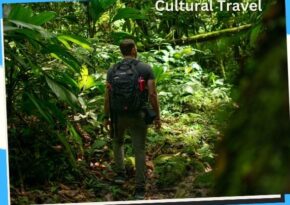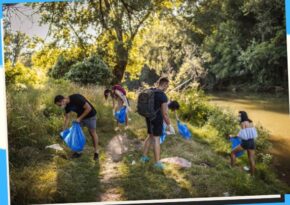
Harnessing Nature’s Power: Eco-Friendly Hydropower Turbine Revolutionizes Tourism
Discover the groundbreaking technology reshaping tourism with an environmentally-friendly hydropower turbine. Learn how it not only generates clean energy but also protects fish populations, making it a win-win for both tourism and the environment.
Harnessing the Power of Nature: Eco-Friendly Hydropower Turbines in Tourism 🌊
Hydropower turbines have long been celebrated for their ability to generate clean energy from flowing water, but traditional designs have posed significant challenges for aquatic ecosystems, particularly fish populations. However, a new wave of environmentally friendly hydropower turbines is emerging, offering sustainable energy solutions without sacrificing the health of our rivers and marine life. In this guide, we’ll explore the innovative technology behind fish-saving hydropower turbines and their potential applications in the tourism industry, where sustainability and conservation are increasingly valued.
1. Understanding the Impact of Traditional Hydropower on Fish Populations 🐟
Traditional hydropower turbines, such as dams and diversion structures, can have detrimental effects on fish populations and aquatic ecosystems. Some common impacts include:
- Obstructions: Dams and weirs create physical barriers that impede the natural migration patterns of fish, hindering their ability to access spawning grounds and essential habitats.
- Turbine Mortality: Fish that pass through traditional turbine blades may suffer injury or mortality due to collisions, pressure changes, and shear forces, leading to population declines and ecological imbalances.
- Habitat Alteration: The construction of dams and reservoirs can alter water flow, temperature, and sediment transport, disrupting the natural habitats and food sources of aquatic species.
2. Introducing Fish-Saving Hydropower Turbines 🐠
Fish-saving hydropower turbines are designed with the well-being of aquatic ecosystems in mind, incorporating features and technologies to minimize harm to fish and other aquatic organisms. Some key characteristics of fish-saving turbines include:
- Fish-Friendly Design: Fish-saving turbines feature specialized designs, such as low-pressure turbine blades, bypass channels, and fish-friendly intakes, that reduce the risk of fish injury and mortality during passage.
- Variable Speed Operation: Some fish-saving turbines utilize variable speed operation and blade pitch adjustments to optimize turbine efficiency while minimizing impacts on fish passage and survival.
- Environmental Monitoring: Advanced monitoring systems and sensors are integrated into fish-saving turbines to track fish behavior, passage rates, and survival outcomes, allowing for real-time adjustments and adaptive management strategies.
- Hydraulic Modeling: Computational fluid dynamics (CFD) and hydraulic modeling techniques are used to simulate water flow patterns, turbulence levels, and fish behavior around turbines, informing design improvements and optimization efforts.
3. Applications of Fish-Saving Hydropower Turbines in Tourism 🌟
The tourism industry presents unique opportunities for the integration of fish-saving hydropower turbines, particularly in eco-friendly resorts, adventure destinations, and nature-based tourism attractions. Some potential applications include:
- Off-Grid Power Generation: Install fish-saving turbines to generate clean, renewable energy for off-grid facilities, such as remote lodges, eco-camps, and wilderness retreats, reducing reliance on fossil fuels and minimizing environmental impact.
- Scenic River Tours: Incorporate fish-saving turbines into scenic river tours and recreational activities, allowing tourists to experience the beauty of flowing water while learning about sustainable energy practices and conservation efforts.
- Wildlife Viewing Platforms: Construct wildlife viewing platforms and interpretive centers near fish-friendly hydropower installations, providing tourists with opportunities to observe fish passage and learn about local aquatic ecosystems and biodiversity.
- Educational Programs: Develop educational programs, guided tours, and interactive exhibits that highlight the ecological benefits of fish-saving hydropower turbines and promote environmental stewardship among tourists and local communities.
4. Best Practices for Implementing Fish-Saving Hydropower in Tourism 💧
When integrating fish-saving hydropower turbines into tourism operations, it’s essential to prioritize environmental sustainability, wildlife conservation, and community engagement. Consider the following best practices:
- Environmental Impact Assessment: Conduct comprehensive environmental impact assessments to evaluate the potential effects of fish-saving hydropower installations on local fish populations, habitats, and water quality.
- Stakeholder Engagement: Engage with stakeholders, including local communities, indigenous groups, environmental organizations, and regulatory agencies, to gather input, address concerns, and build support for fish-friendly hydropower projects.
- Mitigation Measures: Implement mitigation measures, such as fish passage enhancements, habitat restoration initiatives, and water quality monitoring programs, to minimize adverse impacts and enhance the ecological resilience of affected ecosystems.
- Public Outreach: Launch public outreach campaigns and community engagement initiatives to raise awareness about the benefits of fish-saving hydropower turbines, solicit feedback from stakeholders, and foster a sense of stewardship and responsibility among tourists and residents.
5. Case Studies: Success Stories in Sustainable Tourism 🌿
Several eco-friendly resorts and tourism destinations around the world have successfully integrated fish-saving hydropower turbines into their operations, demonstrating the feasibility and benefits of sustainable energy practices. Some notable case studies include:
- Salmon-Safe Lodges: Eco-lodges and resorts in the Pacific Northwest have installed fish-saving hydropower turbines in salmon-bearing rivers, earning certification as “Salmon-Safe” destinations and attracting environmentally-conscious tourists.
- Adventure Parks: Outdoor adventure parks and ecotourism attractions in Costa Rica and New Zealand have incorporated fish-friendly hydropower installations into their facilities, providing visitors with thrilling experiences while promoting renewable energy and conservation.
- Cultural Heritage Sites: Historic landmarks and cultural heritage sites, such as water mills and traditional fishing villages in Europe and Asia, have revitalized their heritage by retrofitting existing hydropower infrastructure with fish-saving technologies, preserving cultural traditions while embracing sustainability.
6. The Future of Sustainable Tourism with Fish-Saving Hydropower 🌎
As the tourism industry continues to evolve in response to growing environmental concerns and consumer preferences, the integration of fish-saving hydropower turbines offers a promising pathway toward sustainable tourism development. By harnessing the power of flowing water while safeguarding aquatic ecosystems and supporting local communities, fish-friendly hydropower has the potential to shape a more resilient, equitable, and environmentally friendly future for tourism around the world.
Benefits of Environmentally-Friendly Hydropower Turbines in Tourism
- Clean Energy Generation: Harness the power of flowing water to generate clean, renewable energy without relying on fossil fuels, reducing carbon emissions and combating climate change.
- Cost-Efficiency: Benefit from lower operating costs and long-term savings compared to traditional energy sources, enhancing the economic viability of tourism operations.
- Sustainable Development: Align tourism development with sustainable practices by prioritizing renewable energy solutions that minimize environmental impact and promote responsible stewardship of natural resources.
- Fish-Friendly Design: Protect aquatic ecosystems and fish populations by incorporating fish-friendly turbine designs that minimize habitat disruption and mortality rates, supporting biodiversity conservation efforts.
- Community Engagement: Foster community involvement and support for tourism initiatives by promoting the use of environmentally friendly technologies that prioritize local environmental and social concerns.
- Educational Opportunities: Raise awareness about renewable energy and environmental conservation among tourists and local communities through educational tours, exhibits, and interpretive programs at hydropower facilities.
- Diversification of Energy Sources: Diversify energy sources and reduce dependence on grid electricity, enhancing energy security and resilience in remote or off-grid tourism destinations.
- Enhanced Visitor Experience: Provide tourists with unique opportunities to learn about and experience sustainable energy production firsthand, enriching their travel experiences and fostering a deeper connection with nature.
- Positive Brand Image: Enhance the reputation and appeal of tourism destinations by promoting eco-friendly initiatives and demonstrating a commitment to environmental sustainability and responsible tourism practices.
- Preservation of Natural Resources: Contribute to the preservation of natural landscapes, waterways, and ecosystems by reducing the environmental footprint of tourism activities and infrastructure.
Case Studies: Real-Life Examples
- Banff National Park, Canada: The Banff Hydropower Project integrates fish-friendly turbine technology into hydropower facilities, supporting both clean energy generation and conservation of native fish species such as bull trout and west slope cutthroat trout.
- Costa Rica: Sustainable tourism lodges and resorts in Costa Rica utilize small-scale hydropower systems to generate clean energy while minimizing environmental impact in sensitive ecosystems such as rainforests and coastal areas.
- Norwegian Fjords: Hydropower turbines installed in Norwegian fjords power eco-friendly cruise ships and tourist facilities, offering visitors a glimpse into the country’s commitment to renewable energy and environmental sustainability.
- Lake Tahoe, USA: The Lake Tahoe Hydropower Project employs fish-friendly turbine designs to generate clean energy from the lake’s abundant water resources while safeguarding the habitat of native fish species such as Lahontan cutthroat trout and mountain whitefish.
- New Zealand: Adventure tourism operators in New Zealand utilize micro-hydropower systems to power remote lodges and eco-tours, reducing reliance on diesel generators and minimizing environmental impact in pristine wilderness areas.
- Switzerland: The Swiss Tourism Hydropower Initiative promotes the use of hydropower turbines in tourism facilities and attractions across the country, showcasing Switzerland’s commitment to sustainability and renewable energy leadership.
- Amazon Rainforest, Brazil: Eco-lodges and sustainable tourism operators in the Brazilian Amazon harness the power of small-scale hydropower turbines to provide electricity for remote accommodations while minimizing deforestation and ecosystem disturbance.
- Scottish Highlands: Hydropower turbines installed in the Scottish Highlands power eco-friendly glamping sites and outdoor adventure centers, offering tourists an immersive experience in the region’s rugged landscape and renewable energy innovation.
- Bhutan: The Kingdom of Bhutan prioritizes hydropower development as a key pillar of its sustainable tourism strategy, capitalizing on its abundant water resources to generate clean energy while preserving the country’s pristine natural environment.
- Great Barrier Reef, Australia: Tourism operators on the Great Barrier Reef deploy innovative fish-friendly turbine technology to power dive boats, research stations, and eco-resorts, minimizing underwater noise pollution and habitat disruption in sensitive marine ecosystems.
Key Takeaways for Sustainable Tourism Development
- Holistic Planning: Integrate sustainability principles into tourism development plans, considering environmental, social, and economic impacts to ensure long-term viability and resilience.
- Stakeholder Collaboration: Engage local communities, government agencies, tourism operators, and conservation organizations in collaborative efforts to promote sustainable tourism practices and renewable energy solutions.
- Environmental Impact Assessment: Conduct thorough environmental impact assessments to evaluate the potential effects of hydropower projects on aquatic ecosystems, wildlife habitats, and cultural heritage sites.
- Mitigation Measures: Implement mitigation measures such as fish-friendly turbine designs, habitat restoration efforts, and wildlife monitoring programs to minimize adverse impacts on biodiversity and ecosystem health.
- Public Outreach and Education: Educate tourists and local communities about the benefits of sustainable tourism and renewable energy through interpretive signage, guided tours, and educational materials at hydropower facilities.
- Policy Support: Advocate for supportive policies and incentives that encourage the adoption of renewable energy technologies and sustainable tourism practices, such as tax incentives, subsidies, and regulatory frameworks.
- Adaptive Management: Monitor and adaptively manage hydropower operations to respond to changing environmental conditions, stakeholder feedback, and emerging conservation priorities.
- Community Benefits: Ensure that local communities benefit from hydropower development through job creation, revenue-sharing agreements, infrastructure improvements, and capacity-building initiatives.
- Ecosystem Restoration: Invest in ecosystem restoration projects and conservation initiatives to offset the ecological footprint of tourism activities and enhance the resilience of natural ecosystems.
- Continuous Improvement: Embrace a culture of continuous improvement and innovation in sustainable tourism development, seeking opportunities to enhance energy efficiency, minimize waste, and maximize positive social and environmental outcomes.
FAQs: Answers to Common Questions
- Q: How do fish-friendly hydropower turbines work?
A: Fish-friendly turbines feature designs such as low-pressure intakes, smooth surfaces, and protective screens to minimize injury or mortality of fish passing through the turbine. - Q: Are there any potential drawbacks or limitations to using hydropower in tourism?
A: Challenges may include environmental impacts on aquatic ecosystems, regulatory hurdles, upfront capital costs, and concerns about visual or aesthetic impacts in scenic areas. - Q: What role can tourists play in supporting sustainable hydropower initiatives?
A: Tourists can support sustainable hydropower initiatives by choosing eco-friendly accommodations, participating in educational tours, and advocating for responsible tourism practices. - Q: How can hydropower projects benefit local communities in tourism destinations?
A: Hydropower projects can provide opportunities for local employment, infrastructure development, revenue generation, and capacity-building in areas where tourism is a key economic driver. - Q: What steps can tourism operators take to minimize their environmental footprint when using hydropower?
A: Tourism operators can prioritize energy efficiency, water conservation, waste reduction, and responsible land management practices to minimize their environmental impact and support sustainable tourism development. - Q: Are there any alternative renewable energy sources that tourism destinations can explore besides hydropower?
A: Yes, alternative renewable energy sources for tourism include solar power, wind power, geothermal energy, and biomass energy, each with its own unique benefits and considerations. - Q: How can hydropower projects address concerns about wildlife conservation and habitat protection?
A: Hydropower projects can incorporate wildlife-friendly design features, habitat restoration measures, and adaptive management strategies to mitigate impacts on wildlife and ecosystems. - Q: What regulatory approvals are required for implementing hydropower projects in tourism destinations?
A: Regulatory approvals may include environmental assessments, permits for water use and land disturbance, consultations with indigenous communities, and compliance with wildlife protection laws. - Q: How do hydropower projects contribute to climate change mitigation and adaptation in tourism destinations?
A: Hydropower projects provide a renewable alternative to fossil fuel-based energy sources, reducing greenhouse gas emissions and enhancing the resilience of tourism infrastructure to climate-related risks such as extreme weather events and sea-level rise. - Q: Where can I find more information about sustainable hydropower initiatives in tourism?
A: You can find more information from government agencies, non-profit organizations, academic institutions, and industry associations focused on sustainable tourism, renewable energy, and conservation.
Conclusion: Pioneering Sustainable Tourism with Eco-Friendly Hydropower
Incorporating fish-saving hydropower turbines into tourism operations represents a win-win solution for balancing energy needs with environmental conservation and sustainable development goals. By embracing innovative technologies, engaging stakeholders, and adopting best practices in sustainable tourism management, we can create tourism experiences that not only delight and inspire visitors but also contribute to the preservation and restoration of our natural heritage for generations to come. Let’s harness the power of nature responsibly and re-imagine the future of tourism with fish-saving hydropower.
Key Phrases
- Environmentally-Friendly Hydropower Turbine
- Sustainable Tourism Innovation
- Fish-Saving Hydropower Turbine
- Eco-Tourism
- Environmental Conservation in Tourism
- Wildlife Protection
- Sustainable Energy Solutions
- Responsible Travel
- Green Tourism
- Tourism Industry Sustainability
Best Hashtags
- #SustainableTourism
- #HydropowerInnovation
- #EcoFriendlyTravel
- #WildlifeConservation
- #RenewableEnergyTourism
- #GreenDestinations
- #ResponsibleTourism
- #FishFriendlyTurbines
- #EcoTourism
- #EnvironmentallyFriendly
DisclaimerThe information is for educational purposes only and subject to change, and it is highly recommended to consult local authorities for the latest and most accurate updates. We do not constitute endorsement of any specific technologies or methodologies or endorse of any specific products or services.📩 Need to get in touch?Feel free to Email Us for comments, suggestions, reviews, or anything else. |








Comments (0)